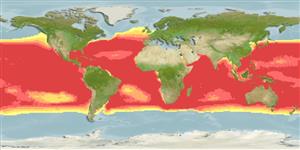Ακτινοπτερύγιοι >
Perciformes (Perch-likes) >
Scombridae (Mackerels, tunas, bonitos) > Scombrinae
Etymology: Thunnus: Greek, thynnos = tunna (Ref. 45335).
Περιβάλλον / Κλίμα / Εύρος
Οικολογία
; Θαλασσινό(ά); Υφάλμυρο; ωκεανόδρομο(ς) (Ref. 51243); εύρος βάθους 1 - 250 m (Ref. 6390), usually 1 - 100 m (Ref. 55289). Tropical; 15°C - 31°C (Ref. 168), preferred 28°C (Ref. 107945); 59°N - 48°S, 180°W - 180°E
Worldwide in tropical and subtropical seas, but absent from the Mediterranean Sea. Highly migratory species, Annex I of the 1982 Convention on the Law of the Sea (Ref. 26139).
Length at first maturity / Μέγεθος / Βάρος / Age
Maturity: Lm 103.3, range 78 - 158 cm
Max length : 239 cm FL αρσενικό/απροσδιόριστο; (Ref. 40637); common length : 150 cm FL αρσενικό/απροσδιόριστο; (Ref. 168); μεγ. δημοσιευμένο βάρος: 200.0 kg (Ref. 26550); μεγ. αναφερόμενη ηλικία: 9 έτη (Ref. 72462)
Ραχιαίες άκανθες (συνολικά): 11 - 14; Μαλακές ραχιαίες ακτίνες (συνολικά): 12-16; Εδρικές άκανθες 0; Μαλακές εδρικές ακτίνες: 11 - 16; Σπόνδυλοι: 39. Fish with very long second dorsal fin and anal fin, which in some may reach well over 20% of the FL. The pectoral fin is moderately long, usually reaching beyond the second dorsal fin origin but not beyond the end of its base. Color is black metallic dark blue changing through yellow to silver on the belly. The belly frequently has about 20 broken, nearly vertical lines. The dorsal and anal fins and finlets are bright yellow.
An oceanic species occurring above and below the thermoclines. Pelagic in open water , but rarely seen near reefs (Ref. 48637). They school primarily by size, either in monospecific or multi-species groups. Larger fish frequently school with porpoises, also associated with floating debris and other objects. Feed on fishes, crustaceans and squids. It is sensitive to low concentrations of oxygen and therefore is not usually caught below 250 m in the tropics (Ref. 28952, 30329). Peak spawning occurs during the summer, in batches (Ref. 9684, 51846). Eggs and larvae are pelagic (Ref. 6769). Encircling nets are employed to catch schools near the surface (Ref. 9340). Marketed mainly frozen and canned (Ref. 9684), but also fresh (Ref. 9340) and smoked (Ref. 9987). Highly valued for sashimi (Ref. 26938).
Spawn throughout the tropical and equatorial waters of the major oceans (Ref. 6390). At higher latitudes, spawning is seasonal, with peaks in summer; may continue throughout the year at lower latitudes (Ref. 6390).
Yellowfin tuna are multiple spawners, ie they spawn every few days over the spawning period (Ref. 6390). Eggs and sperm are released into the water for fertilisation (Ref. 6390).
Collette, B.B. and C.E. Nauen, 1983. FAO Species Catalogue. Vol. 2. Scombrids of the world. An annotated and illustrated catalogue of tunas, mackerels, bonitos and related species known to date. Rome: FAO. FAO Fish. Synop. 125(2):137 p. (Ref. 168)
IUCN Red List Status (Ref. 115185)
CITES (Ref. 94142)
Not Evaluated
Threat to humans
Harmless
Human uses
αλιεία: πολύ εμπορικό; Υδατοκαλλιέργειες: πειραματικό; αλιεία αναψυχής: ναί
Εργαλεία
Special reports
Download XML
Διαδικτυακές πηγές
